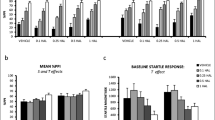Abstract
The dose-dependent effect of acute zimeldine and alaproclate treatment upon the acquisition of two-way and one-way active avoidance in the rat was studied in a single-session and in a repeated-sessions design. Zimeldine (5–20 mg/kg, IP), but not alaproclate, caused disruptions of two-way avoidance acquisition. Acquisition deficits were also caused by citalopram and fluoxetine but not the other antidepressant drugs tested. Zimeldine, but not alaproclate or desipramine, caused a slight but non-significant impairment of one-way active avoidance; neither zimeldine nor alaproclate produced any effects upon fear conditioning and retention testing. The long-term action of p-chloroamphetamine (2×10 mg/kg) antagonised the acute zimeldine effect totally, and chronic treatment with zimeldine (15 days, 1×50 μmol/kg) and chlorimipramine (15 days, 2×10 μmol/kg) also caused some partial blockade of the two-way avoidance deficit. These data seem to suggest some involvement of serotonin (5-HT) in the observed disruptions of two-way active avoidance caused by acute zimeldine treatment.
Similar content being viewed by others
References
Archer T (1982a) DSP4 (N-2-chloroethyl-N-ethyl-2-bromobenzyl-amine), a new noradrenaline neurotoxin, and the stimulus conditions affecting acquisition of two-way active avoidance. J Comp Physiol Psychol 96:476–490
Archer T (1982b) Serotonin and fear retention in the rat. J Comp Physiol Psychol 96:491–516
Archer T (1982c) Signalled and unsignalled avoidance impairments following noradrenaline depletion with DSP4: an hypothesis incorporating an associative and non-associative factor. Scand J Psychol 1983:75–87
Archer T, Ögren SO, Johansson C (1981) The acute effect of p-chloroamphetamine on the retention of fear conditioning in the rat: Evidence for a role of serotonin in memory consolidation. Neurosci Lett 25:75–81
Baumann PA, Maitre L (1977) Blockade of presynaptic α-receptors and of amine uptake in the rat brain by the antidepressant mianserine. Naunyn-Schmiedeberg's Arch Pharmacol 300:31–37
Essman WB (1970) Some neurochemical correlates of altered memory consolidation. Trans NY Acad Sci 32:948–973
Fuller RW, Perry KW, Molloy B (1974) Effect of an uptake inhibitor on serotonin metabolism in rat brain: studies with 3-(p-trifluormethylphenoxy-)-N-methyl-3-phenylpropylamine (Lilly 1101140). Life Sci 15:1161–1171
Fuller RW, Perry KW, Molloy BB (1975) Reversible and irreversible phases of serotonin depletion by 4-chloroamphetamine. Eur J Pharmacol 33:119–124
Gyermek LL (1966) The pharmacology of imipramine and related antidepressants. Int Rev Neurobiol 9:95–143
Hall H, Ögren SO (1981) Effects of antidepressant drugs on different receptors in the brain. Eur J Pharmacol 70:393–407
Hano J, Vetulani J, Sansoe M, Oliverio A (1981) Changes in action of tricyclic and tetracyclic antidepressants: Desipramine and mianserin on avoidance behaviour in the course of the chronic treatment. Psychopharmacology 73:265–268
Harvey JA (1978) Neurotoxic action of halogenated amphetamines. Ann NY Acad Sci 305:289–304
Harvey JA, McMaster SE (1976) Neurotoxic action of parachloroamphetamine in the rat as revealed by Nissl and silver stains. Psychopharmacol Bull 12:62–64
Herr F, Stewart J, Charest MP (1961) Tranquilizers and antidepressants: A pharmacological comparison. Arch Int Pharmacodyn Ther 134:328–342
Hyttel J (1982) Citalopram-pharmacological profile of a specific serotonin uptake inhibitor with antidepressant activity. Prog Neuro Psychopharmacol Biol Psychiatr 6:277–295
Köhler C, Ross SB, Srebro B, Ögren SO (1978) Long-term biochemical and behavioural effects of p-chloroamphetamine in the rat. Ann NY Acad Sci 305:645–663
Lindberg UH, Thorberg SO, Bengtsson S, Renyi AL, Ross SB, Ögren SO (1978) Inhibitors of neuronal monoamine uptake. 2. Selective inhibition of 5-hydroxytryptamine uptake by α-amino acid esters of phenethyl alcohols. J Med Chem 21:448–456
Maj J, Sowinska H, Baran L, Garncarczyk L, Rawlow A (1978) The central antiserotonergic action of mianserin. Psychopharmacology 59:79–84
Ögren SO (1982) Central serotonin neurons and learning in the rat: In: Osborne NN (ed) Biology of serotonergic transmission. John Wiley & Sons, London, pp 317–334
Ögren SO, Fuxe K, Archer T, Johansson G, Holm AC (1982) Behavioural and biochemical studies on the effects of acute and chronic administration of antidepressant drugs on central serotonergic receptor mechanisms. In: Langer SZ, Rakahashi R, Segawa T, Briley M (eds) New vistas in depression. Pergamon Press, New York, pp 11–19
Ögren SO, Holm AC (1980) Test-specific effects of the 5-HT re-uptake inhibitors alaproclate and zimeldine on pain sensitivity and morphine analgesia. J Neural Transm 47:253–271
Ögren SO, Holm AC, Hall H, Lindberg UH (1984) Alaproclate, a new selective 5-HT uptake inhibitor with therapeutic potential in depression and senile dementia. J Neural Trans 59:265–288
Ögren SO, Johansson C, Johansson G, Archer T (1982) Serotonin neurones and aversive conditioning in the rat. Scand J Psychol Suppl 1:7–15
Ross SB (1976) Antagonism of the acute and long-term biochemical effects of 4-chloroamphetamine on the 5-HT neurones in the rat brain by inhibitors of the 5-hydroxytryptamine uptake. Acta Pharmacol Toxicol 39:456–476
Sansoe M (1978) Effects of chlordiazepoxide, amitryptyline, imipramine, and their combinations on avoidance behaviour in mice. Psychopharmacology 59:151–155
Sigg EB (1968) Tricyclic thymoleptic agents and some newer antidepressants. In: Efron DH (ed) Psychopharmacology — a review of progress 1957–1967. Publication No. 1836. Public Health Service, Washington
U'Prichard DC, Greenberg DA, Sheehan PP, Snyder SH (1978) Tricyclic antidepressants. Therapeutic properties and affinity for α-noradrenergic receptor binding sites in the brain. Science 199:197–198
Author information
Authors and Affiliations
Rights and permissions
About this article
Cite this article
Archer, T., Ögren, SO., Johansson, G. et al. The effect of acute zimeldine and alaproclate administration on the acquisition of two-way active avoidance: Comparison with other antidepressant agents, test of selectivity and sub-chronic studies. Psychopharmacology 84, 188–195 (1984). https://doi.org/10.1007/BF00427444
Received:
Accepted:
Issue Date:
DOI: https://doi.org/10.1007/BF00427444




